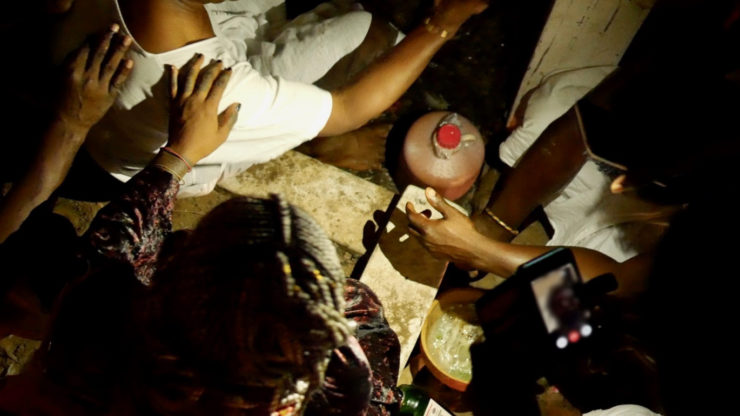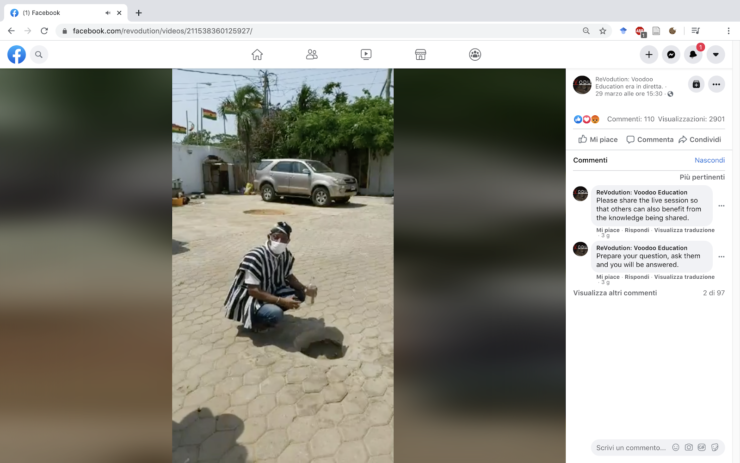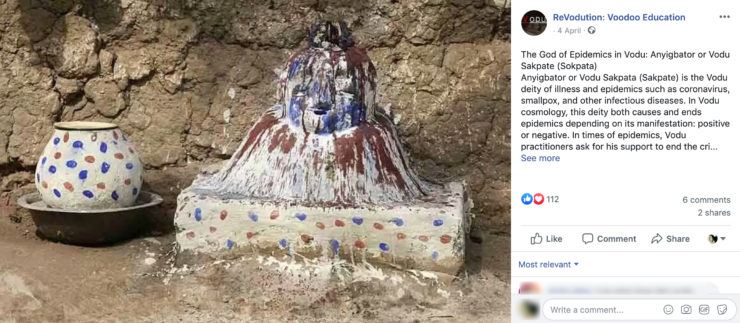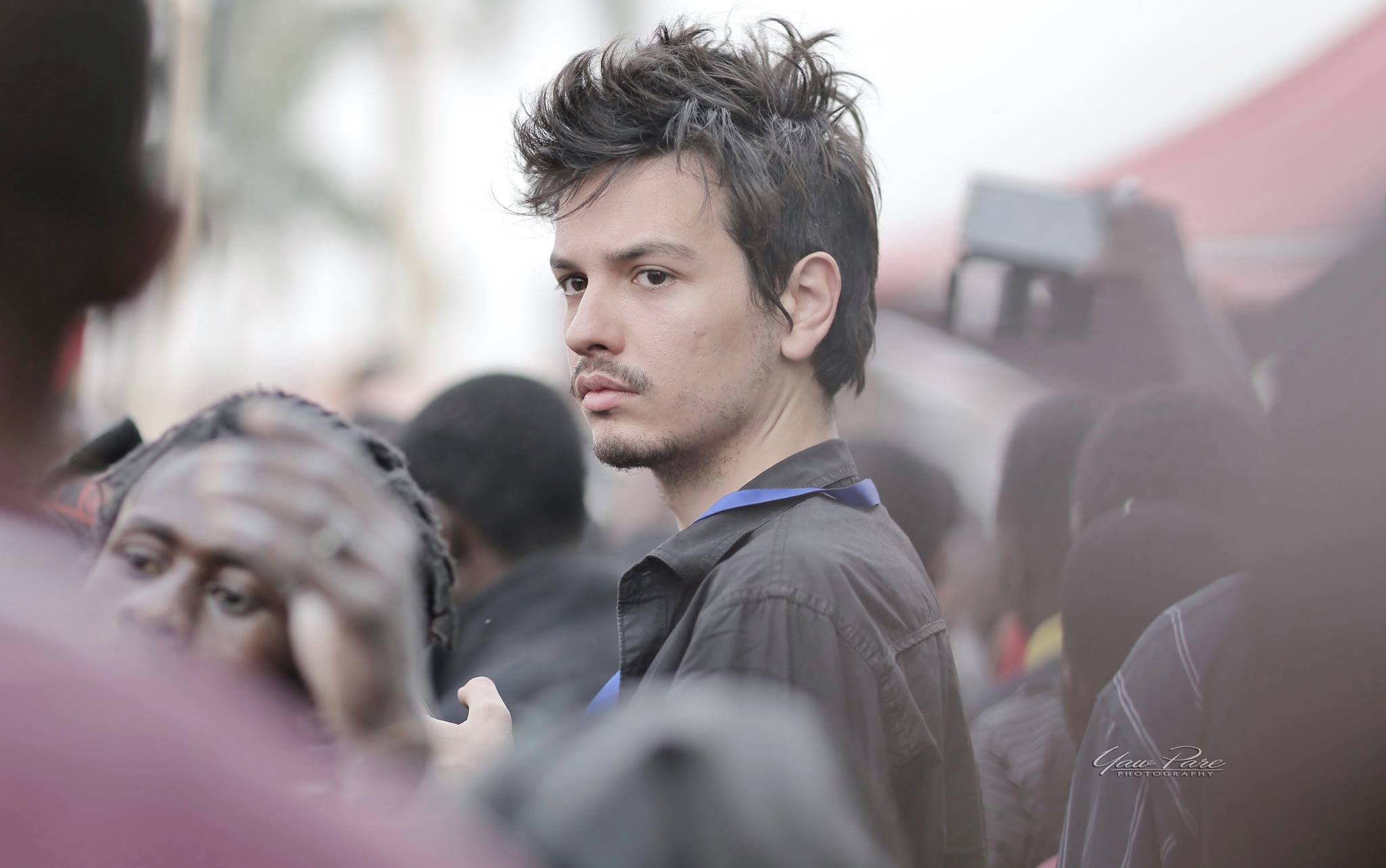Religion on lockdown: on the articulation of Vodu, media and science
Angelantonio Grossi
The unfolding events related to the spreading of Covid-19 among the world population have triggered different responses. With various countries that went into regimes of lockdown, for many people — those who can afford to “stay home” — social life has experienced a shift. Reshaped around the need to put physical distance between bodies in the attempt to mitigate contagion risks and protect social reproduction, daily lives gravitate more than ever around screens.
From a European perspective, digital technologies of communication have been invested with almost salvific powers to keep things together. Going online is the one-for-all solution, a promise that eventually things will bode well, back to normality. Of course, this digitalization of governance and the rise of tech-solutionism applied to social problems is not new. It could be argued that such tools were already enmeshed with existing power structures — venture capitalism, pervasive surveillance, extractive economies and so on. At same time it is undeniable that these technologies have become a prominent component of social life. But, given the great magnitude of effects, the debate is open as to whether in the long run the pandemic could pave the road for an intensification of techno-totalitarian horizons, or allow for a possible rethinking and disruption of existing socio-political regimes of exploitation.
Rather than approaching this conundrum in such a dichotomic way, here I try to look at things from a different perspective. I will present an overview on the engagements of my field-sites with the reality of the pandemic.
Starting from 2016, I’ve been interested in the increasing prominence of Ghana-based traditional priests and priestesses over social media platforms. Pivotal for the emergence of geographically dispersed communities that revolve around Ghanaian shrines and their spirits, I followed how corporate social media platforms like Facebook, Instagram and Whatsapp are embedded in an infrastructure of presencing that allows for a constant circulation of forms of spiritual power.
By taking into account the singularity of this historical moment, what kind of insights can we gain from this setting?
Religion on lockdown
In times of lockdown, the banning of “non essential” gatherings has put a halt to religious services. Images of empty mosques and churches populate news programs. The petition to embrace digital media as a way to cope and stick with containment and mitigation measures also means that habituation has to be reinvented. In case of religious activities, the disruption of habits among practitioners of any religion is having different effects. For instance, in Italy there have been reported cases of “clandestine masses”, but also of “prayers from the balconies” and Easter solo processions live-streamed on Facebook. The issue opened a debate around what counts as essential in times of emergency, but also on how religion deals with media and technologies. If the study of religion from a material perspective has been attentive to highlight the conceptual fallacy of considering the two as separate fields, the current situation opens interesting opportunities to track how religious organizations deal with the urgency of having to adapt to the new conditions.
But first, despite the feeling that unprecedented events are unfolding around us, it might be worthy to listen to medical historians. They remind us that quarantine measures are less an unprecedented reaction in today’s globalized world than a fundamental feature of it.
The influenza epidemic of 1918-19 also took the world by storm spreading globally. It reached Ghana (Gold Coast at that time) and, in a very short period of just a few months, left thousands of deaths behind. As it was reported decades later, in the north of the country “even the smallest villages remember the disaster” (Patterson, 1995). The epidemic prompted a series of reactions that had effect both in the spatial arrangements — by introducing new factors in the urban planning of Accra for the dislocation of native population (Quayson, 2014) — and in the religious setting. The fear caused by the disease opened new possibilities for proselytization since biomedicine and existing religious actors failed to provide meaningful and effective strategies. Amid the epidemic, the Islamic movement of Ahmaddiyya entered the Gold Coast with its End Times message that, instead of offering spiritual healing, had explanations for the calamity (Hanson, 2017). Similarly, the newly arrived Pennsylvanian Faith Tabernacle Congregation managed to give shelter to sick people around the city of Winneba, while most churches were closed by government orders. Those who recovered praised the miraculous healing powers of the organization that consequently saw its popularity growing (Mohr, 2011).
Moving to present days and keeping the focus on Ghana: on the 30th of March 2020 the country entered a partial lockdown. As reported by Samuel Ntewusu, local churches started streaming their services on social media. This also is the case with the organization of one of the most popular pastors in the country, Mensa Otabil. His International Central Gospel Church released a statement in mid-March, announcing the shifting of all its activities to online platforms. But it must be clarified that the move is not entirely new since televangelism has been a trait of the vibrant Ghanaian religious setting in the last 30 years (De Witte, 2012). In present-day, the country is populated by a multiplicity of actors that have been adopting digital technology in the context of spiritual activities for a while now.

The transition toward videographic forms of presence has been in place for long among traditionalists in Ghana. So, in the present-day situation, they are quite at ease in welcoming people to their digitally mediated services. Indeed, as I noticed during my fieldwork, the expertise in spirit mediumship offered by priests and priestesses is a resource people mobilize in times of danger and crisis. The spirits they operate with inhabit the world and move across geographical distance. For one of the priests I follow, the Vodu priest (bokor) Christopher Voncujovi, to have clients living outside the country who ask for spiritual consultations is a daily job. He is well versed in adapting his knowledge to the interactions allowed by digital media. Using mobile networks, smartphones and social media, he assists his clients abroad, feeds and sends spirits on their behalf during ceremonies that take place in Accra at his shrine, Afrikan Magick Temple.
Crossing the path of Nature
March 29, as every Sunday, Christopher and his assistants at the shrine in Accra start streaming live on Facebook. Since last year, with the program growing in popularity, the session has become a central event in the life of the shrine. It is especially appealing to social media folks interested in Vodu, the spiritual practices of the Ewe people of Ghana. Also a growing number of priests and priestesses of various Afro-Atlantic religions have started to participate, joining the various social media channels of the temple they share their own experience and knowledge in spiritual matters.
Aside from moments of need, as Christopher says, Vodu is also a way of life that acknowledges the co-presence of other entities, among them spirits that have names and specific needs. It recognizes that human beings are interrelated with broader and at times invisible presences. This aspect of Vodu gets mobilized more and more these days because it offers a lens to understand and deal with the reality we face — that of the virus.
At the beginning of the program, answering the question of “What is the virus pandemic?” Christophers says that: “from time to time such things happen in the world. […] our belief in Vodu is that if we don’t wrong Nature, Nature will not attack us. So in Vodu it is usually believed that maybe man has crossed the path of Nature, of other things in Nature. Because the corona virus has always been around with human beings. This particular kind is not very known but there is nothing new in Nature. […] This corona virus has been there longer than we can ever think about, but it has not really attacked people the way it is attacking people today. Why is it attacking us now? Something surely might have shaken it. And now it is spreading. This is what has happened from my own understanding. […] so we, as humans, probably have done something to strike it and now it is invading us.”

Christopher suggests to take into account the broader field of forces and entities with which humans are entangled. This is what he congeals under the domain of Nature. Thinking with Vodu means to recognize the relationality and the mutually constituting relationship (Matory, 2018) between humans and the rest. Nonetheless, for Christopher, Vodu doesn’t stand in opposition to science, it rather illuminates the proximity and the entanglements of a diversified set of domains — subjects and objects; divine and non-divine; animate and inanimate matter; religion and science — otherwise conceived as distinct and unrelated. It speaks to the relationality of inhabiting a planet where to grasp the rules of Nature means to question the autonomy of humans and their exceptionalism. Perhaps, it is a critique not far from Anna Tsing’s reflection (2012) on the narrative of human mastery that sustains the fantasy of domestication instead of an appreciation of intertwined and interspecies being. A being that is conceptualized as a distributed and sensing capacity embodied in Donna Haraway’s idea of critters (2016): the promiscuity of microbes, plants, animals, humans and nonhumans.
While Christian pastors in Ghana are facing critiques and have to clarify on “God’s ability to deliver his people in times of crisis” (see Asamoah-Gyadu here), Vodu, as profiled by Christopher, emerges out of the temporalizing frame that has long been attached to traditional knowledge. It does so by mobilizing networks of people from all over the world and by carrying a perspective that only seemingly stands in contradiction with the scientific frame. The initiative #Vodu4Corona launched by ReVodution spotlights that.
#Vodu4Corona
ReVodution is a platform related to Christopher’s shrine. Led by Sena and Pele Voncujovi, it “aims to digitally preserve Vodu wisdom and educate people about its practices”, with the goal to demystify and de-stigmatize Vodu tradition. In March 2020 it launched an initiative labeled #Vodu4Corona. It is meant to sensitize people about the threat of the virus, following the directions of WHO and the African CDC.
The purpose to comply with the approach of secular public health players like WHO might be taken to stand in contrast to the idea of Vodu as radically other, or even as backward — a perspective seldom applied to so-called alternative traditional healing. But that’s not really the case. Following Osseo-Asare (2014), we know that biomedicine and African Traditional healing are not only complementary but have also been adapted and borrowed things from each other.
Vodu practitioners show us that apparently different sets of knowledge are actually co-produced together, as the trajectories of many medicine plants into pharmaceutical products and the history of vaccination also prove. Furthermore, an initiative as #Vodu4Corona counters the narrative that portrays Africa and its “traditions” as irredeemable haunted by anti-scientific thought. On the contrary, science and Vodu appear here to mutually support one another, as they share a common goal. Indeed, the central argument of the initiative is the contribution African traditional practitioners can make to contain and stop the spreading of Covid-19.
A practical example: Sakpata is a Vodu spirit known to inflict humans with sickness. It is considered to be the one responsible and in charge of epidemics and contagious diseases. One of the messages tagged as #Vodu4Corona illustrates that:
“In times of epidemics, Vodu practitioners ask for his support to end the crisis. Anyigbator or Vodu Sakpata (Sakpate) is the Vodu deity of illness and epidemics such as coronavirus, smallpox, and other infectious diseases.
In these Coronavirus times, we advise that you make offerings to Anyigbator to be on his good side while also following all the safety precautions (i.e. washing hands, social isolation, etc) prescribed by WHO, African Union, and other relevant medical bodies. Because you are a traditional practitioner does not mean you should only take advice from traditional healers or practitioners. We advise that you take the dual approach that combines both traditional and conventional healing methods.”
~
Again, Vodu modes of understanding and coping with a world-scale emergency occur to encompass conceptual boundaries and artificial oppositions. Above all, the need to question the harsh distinction between science and tradition is more and more pressing. As they both deal with Nature and its rule, the openness of Vodu allows its practitioners to embrace science because the two are in no contradiction. Moreover, thinking with Vodu rather debunks a layer often left untold by scientific thought: the sense of human mastery over being in the world.
While virologists, epidemiologists, physicians, health care workers, public health experts, administrators and politicians struggle to deal with the reality of a virus that travels by air, we could try to locate Sakpata as the one really in charge. This does not imply the endorsement of an anti-scientific position. As we have seen, the same Vodu practitioners here articulate a view that takes science and its organizations quite seriously. But on top of that, if we relate to the image of Sakpata, they way it “flashes in a moment of danger” could illuminate the condition we are in, by pointing us to rethink the question of sovereignty over a shattered present.

Thanks to Birgit Meyer and Emily Ng for reading and thinking with me on earlier versions of this blogpost.
References
De Witte, M. (2012). Television and the Gospel of Entertainment in Ghana. Exchange, 41(2), 144–164. https://doi.org/10.1163/157254312X633233
Hanson, J. H. (2017). The Ahmadiyya in the Gold Coast: Muslim cosmopolitans in the British Empire. Indiana University Press.
Haraway, D. J. (2016). Staying with the trouble: Making kin in the Chthulucene. Duke University Press.
Matory, J. L. (2018). The fetish revisited: Marx, Freud, and the gods Black people make. Duke University Press.
Mohr, A. (2011). Capitalism, Chaos, and Christian Healing: Faith Tabernacle Congregation in Southern Colonial Ghana, 1918-26. The Journal of African History, 52(1), 63–83. https://doi.org/10.1017/S0021853711000090
Osseo-Asare, A. D. A. (2014). Bitter roots: The search for healing plants in Africa. The Univ. of Chicago Press.
Patterson, K. D. (1995). The Influenza Epidemic of 1918-1919 In the Gold Coast. Transactions of the Historical Society of Ghana, 1 (Vol. 16, 2), 205–225. Jstor.
Quayson, A. (2014). Oxford Street, Accra: City life and the itineraries of transnationalism. Duke University Press.
Tsing, A. (2012). Unruly Edges: Mushrooms as Companion Species: for Donna Haraway. Environmental Humanities, 1(1), 141–154. https://doi.org/10.1215/22011919-3610012
This blog is a part of ‘Dossier Corona’, introduced by Religious Matters in the spring of 2020.

